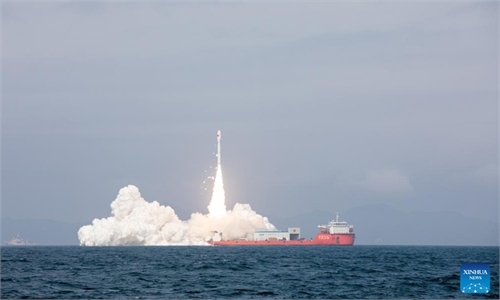Application of China's space-borne infrastructure increasingly capable of serving domestic and overseas users: CASC

Staff members of Xiamen Municipal Marine Environmental Sanitation Management operate a remote sensing satellite system to detect environmental quality in Xiamen sea area, in East China's Fujian province, on January 25, 2024. Photo: Lin Xiaoyi/GT
China's space-borne infrastructure based on technologies including satellite communication, satellite remote sensing and satellite navigation further developed into a rather complete application system in 2023, significantly supporting national strategies of building the country into a cyberspace, maritime, agricultural, transport and cultural power, the China Aerospace Science and Technology Corp (CASC), a state-owned conglomerate and the nation's leading space contractor, said on Thursday.
The CASC disclosed in a statement it provided to the Global Times on Thursday on the sidelines of the ongoing two sessions that application of China's space-borne infrastructure has widely contributed to the national economy, and in a variety of fields such as aviation communication, natural resources survey and public transportation management, providing stable, reliable and high-efficient services.
According to the CASC statement, China Satellite Communications, a CASC subsidiary, continued to increase its construction of high-throughput satellite aviation internet access capabilities in 2023. To illustrate this advancement, the CASC revealed that throughout the year, a total of 12,056 internet-connected flights were opened for Sichuan Airlines, serving 1.66 million passengers.
To serve the China-proposed Belt and Road Initiative (BRI), China's communication satellite signals are now covering the entire China, Southeast Asia, South Asia, the Middle East, Africa, as well as Europe and the Pacific region, offering high-speed broadband network communication and internet access services. This addresses the urgent needs in culture, lifestyle, education, finance, and other areas along the BRI routes, achieving secure, reliable, and seamless information transmission services.
In 2023, continuous efforts were also made to strengthen the scale guarantee and service of natural resource-related businesses on the basis of domestically produced high-resolution satellite remote sensing data. This aimed to meet the demand for high-resolution satellite imagery services in areas such as land, oceans, surveying and mapping, geology and minerals, forestry, and grasslands, serving the natural resource management departments at various levels.
For tasks such as geographical national condition monitoring, annual land use change surveys, remote sensing monitoring, and others, satellite imagery was shared with provincial-level natural resource management departments in 42,000 batches, totaling 1.6765 million scenes, with a total data volume of nearly 2 petabytes.
Utilizing satellite imagery and laser altimetry data, over 10 types of business-standard products, such as stereo image standard products and laser altimetry standard products, were produced, providing technical support for new-type basic surveying and mapping, global geographic information resource construction, geographical national condition monitoring, and more.
In the fields of transportation services, the BeiDou Navigation Satellite System, also known as the BDS, further leveraged its high-precision positioning technology advantages in 2023 to promote the establishment of a smooth, efficient, safe, and green modern transportation system.
Currently, there are more than 8 million road-operated vehicles nationwide utilizing the BDS, 90,000 postal and express delivery vehicles, and 5 million sharing bicycles equipped with BDS chips nationwide, according to data provided by the CASC, the developer of the BDS satellites.
Lane-level high-precision navigation based on BDS has been piloted in multiple cities, and more than 100,000 BDS devices have been promoted and applied in the railway transportation sector, achieving initial large-scale application, CASC said.
In maritime transportation services, smart shipping has been upgraded, with the help of the BDS and other satellite services.
The BDS and satellite communication technology are also applied in ship positioning and maritime operations to enhance vessel navigation safety and waterway traffic efficiency. More than 48,000 vessels across China and over 13,000 waterway navigation facilities have used the BDS. In 2023, the BDS satellite-based augmentation system for the Yangtze River mainline officially commenced operation, achieving full coverage of the Yangtze River with BDS satellite-based augmentation signals.
In support of civil aviation applications, safety and reliability are enhanced. The BDS continues to carry out applications such as air route navigation and precision approach. In 2023, China successfully conducted the first test flight of civil aircraft tracking based on BDS-3. Utilizing the BeiDou short-message communication link, automatic information transmission between aircraft and ground was conducted, achieving full-course positioning and tracking of aircraft during flight.


